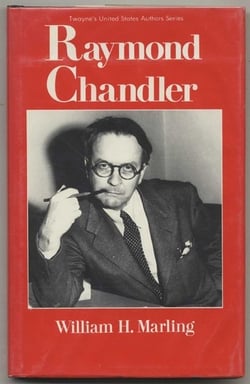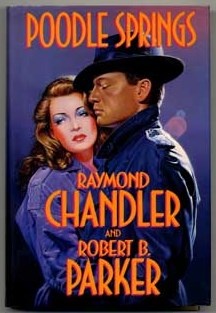Raymond Chandler is one of those rare authors who reminds the literary establishment that genre has no bearing over a book’s quality. Chandler bridged gaps in his career. His work helped bring crime fiction to academics, and the serious novel to Hollywood studios. He considered himself an intellectual snob and loved Charles Dickens, Henry James, and Ernest Hemingway. He was a man who studied Greek and Latin, but Chandler emphasized that his own strange preferences brought him to the world of the detective story.
 Raymond Chandler, an Introduction
Raymond Chandler, an Introduction
Raymond Chandler, the crime fiction writer, was born from the ashes of his former life. Chandler was an oil executive in Southern California. Alcohol would forever be a demon for the author, and it played a role in his fall from corporate grace. His drunkenness, absenteeism, and his relations with female employees led to his firing from the company. It was 1932, in the midst of the Great Depression, and not a great time to be out of work.
Chandler stayed with friends in Seattle for a time. He drove up the Pacific coast and picked up copies of the pulp magazine Black Mask because they were cheap and could be thrown away. He began to compose his own novella for the magazine, an 18,000 word story that took five months to write. He was paid $180 for it. It was a far cry from his salary as an oilman, but it was something.
Chandler’s most famous invention is detective Philip Marlowe, who was introduced to the wide world in The Big Sleep (1939). Marlowe might be the most important fictional detective since Sherlock Holmes. The detective is also inextricable from the hardboiled style, a type of crime fiction in which the mood, atmosphere, and thoughts of the protagonist get priority of treatment. Indeed, Chandler brought to life Los Angeles and Southern California in his fiction, an area that hadn't quite yet found its way into the literature of the United States. Atmosphere and character mattered so much to Chandler that he sometimes neglected to make his ambitious plots fully coherent. When director Howard Hawks was adapting The Big Sleep for cinema, he called up the author asking who had killed the chauffeur. Chandler responded that he didn’t know.
Writing for the Silver Screen
Hollywood was a suitable home for Chandler and his talents. Adaptation rights to his novels sold quickly in the movie business. Chandler began to break into screenwriting himself. He co-wrote Double Indemnity, making $750 a week, far more than he had earned in years. Still, Chandler’s alcoholism and propensity for distraction meant he took his time to write. During an interview with Ian Fleming (a great admirer of Chandler), Chandler was immensely incredulous Fleming could write a James Bond book in two months at his estate in Jamaica. Fleming graciously quipped that it’s very well, Chandler probably writes better novels, anyway.
The movie business was Chandler’s first experience with a rigid deadline. The conflict between the author and time is responsible for one of the century's strangest stories of creativity. Chandler insisted that the only way he would finish the screenplay for The Blue Dahlia in time was if he was kept drunk. Paramount Studios set up quite the accommodation for its intoxicated screenwriter. They kept two limousines running around the clock, a rotation of six secretaries to transcribe Chandler’s ideas, and a doctor to administer glucose injections as the writer neglected to eat during his drunken, creative binges. The typists were trained even to record what the writer muttered in his alcoholic sleep.
Unfortunately, after all the editions and doctoring, there wasn’t too much left of Chandler’s efforts in the filmed script. Chandler wanted out of the film business. While he didn't leave it until much later, he succeeded in distancing himself, and moved to La Jolla and out of L.A..
Championing Popular Literature and Detective Fiction
 Chandler cared very much about asserting the merit of a genre that he felt was smugly dismissed by many readers. He once said that the average novel is no better than the average detective novel, it’s just that the average novel doesn’t get published. His collection The Simple Art of Murder provides critical analyses of many writers. He even outlines some of the features of the type of the detective Philip Marlowe belongs to. “Down these mean streets a man must go who is not himself mean,” he writes of the kind of detective that navigates the seedy underworld of organized crime and corruption that punctuates his novels. In the last decade of his life, Chandler wrote The Long Goodbye (1953), which many consider his best work.
Chandler cared very much about asserting the merit of a genre that he felt was smugly dismissed by many readers. He once said that the average novel is no better than the average detective novel, it’s just that the average novel doesn’t get published. His collection The Simple Art of Murder provides critical analyses of many writers. He even outlines some of the features of the type of the detective Philip Marlowe belongs to. “Down these mean streets a man must go who is not himself mean,” he writes of the kind of detective that navigates the seedy underworld of organized crime and corruption that punctuates his novels. In the last decade of his life, Chandler wrote The Long Goodbye (1953), which many consider his best work.
The twilight of his life was marked by many of the same vices of his middle age, only more exaggerated. Chandler was able to easily spend his accumulated fortune on booze, extravagance, and travel. He drank copiously. He had dramatic, near-suicidal nights. He died at the age of seventy-one, and only seventeen people showed up to his funeral.
Yet, for a writer who began his career at age forty-four, Raymond Chandler was considerably accomplished. He helped to shatter prejudices about the quality inherent in certain genres. Few writers have had such a symbiotic relationship with Hollywood, as well. Anyone who writes so-called genre fiction, or insists on the literary elevation of cinema, can thank Chandler for the avenues he opened.









